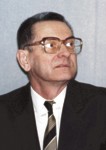 | |
|
Professor Andrzej Zieliński - In Memoriam Professor Andrzej Zieliński, for many years the Scientific Director of the Institute of Oceanology, Polish Academy of Sciences in Sopot, died on 29 April 2003 at the age of 65. A physicist by education, he held the doctoral degree in technical sciences and the Polish habilitacja in physics. Throughout his career, he was an outstanding researcher in plasma physics and atmospheric and marine physics, a university lecturer, an advisor and supervisor for numerous doctoral dissertations and a scientific administrator. Prof. Zieliński graduated from the Department of Physics at Nicolaus Copernicus University in Toruń in 1961. He successfully defended his doctoral dissertation on the theory of high-temperature combustion and was awarded the doctoral degree in the field of technical sciences by the Mechanical Engineering Department of the Technical University of Gdańsk in 1968. In 1978 he earned the Polish habilitacja in the field of physics for his theoretical research on a high-power CO2 fluid flow laser. Prof. Zieliński played a key role in the conceptual development and the subsequent construction of this laser as a member of the team at the Fluid-Flow Laser Laboratory at the Szewalski Institute of Fluid-Flow Machinery, Polish Academy of Sciences in Gdansk. The team received awards from the Scientific Secretary of the Polish Academy of Sciences in 1971 and 1977 for this work. In 1980 Prof. Zieliński began working at the Department of Oceanology, which became the Institute of Oceanology, Polish Academy of Sciences in Sopot in 1984. For many years he was the Director of the Marine Physics Department and served as the institute's Scientific Director from 1990 to 2001. His main interests while at the Institute of Oceanology included modeling thermal and dynamic phenomena in the sea including the biological processes in the upper layer of the sea, the exchange of mass and energy between the sea and the atmosphere as a result of marine aerosol generation and optical phenomena in the atmosphere and the sea with an emphasis on modeling light interaction with phytoplankton cells. Prof. Zieliński was the founder of the Institute of Oceanology's Lidar Laboratory, where state-of-the art lidar methods were developed and applied to processes of aerosol exchange between the sea and the atmosphere and in the studies of fluorescence spectra in the sea. Prof. Zieliński maintained productive working relationships with numerous groups of researchers from institutions such as the University of Gdańsk, University of Szczecin, Pomeranian Pedagogical Academy in Słupsk and the Marine Academy in Gdynia. In addition to scientific cooperation, Prof. Zieliński willingly shared his knowledge and organizational talents and served in the capacity of lecturer in the fields of physics and geophysics. He was an esteemed teacher who was well liked and highly appreciated by his students and colleagues. Prof. Zieliński was a member of many scientific organizations, including the State Committee for Scientific Research, the editorial board of Oceanologia, the Scientific Board of the Szewalski Institute of Fluid-Flow Machinery in Gdańsk; the Committee for Marine Research, PAS; the Committee for Polar Research, PAS; the National Committee on The International Union of Geodesy and Geophysics (IUGG); the Scientific Committee for Ocean Research (SCOR); and the International Association for the Physical Sciences of the Oceans (IAPSO). He served as the Polish representative to the latter two organizations. His scientific portfolio includes over 120 scientific publications, including more than 50 on the subject of the physics of lasers. Prof. Zieliński always shared his knowledge and experience generously and provided numerous graduate students and doctoral candidates with valuable advice. His last doctoral dissertation review remains unfinished. Prof. Zieliński died while writing it. He will remain with us in our thoughts and through the continuous progress of all those who were lucky enough to work and learn from him.
|